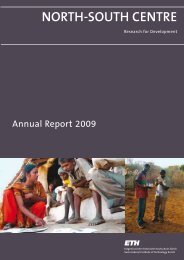Annual Report 2006/07 - ETH - North-South Centre North-South ...
Annual Report 2006/07 - ETH - North-South Centre North-South ...
Annual Report 2006/07 - ETH - North-South Centre North-South ...
You also want an ePaper? Increase the reach of your titles
YUMPU automatically turns print PDFs into web optimized ePapers that Google loves.
Research fellowRicardo Oliva,CIP, Quito, EcuadorSupervisorsCesare Gessler, IPW, <strong>ETH</strong> Zurich /Gregory Forbes, CIP, Lima, PeruCollaboratorWilbert Flier,PRI, Wageningen, The NetherlandsDurationJanuary 2005 – January 2008Research Fellow Partnership Programme (RFPP)Exotic strains of Phytophthora infestans in the Andes –Genetically isolated curiosities ortime bombs for native Solanaceous crops?The plant pathogen Phytophthora infestans sensu lato, thecause of the disease known as late blight, is an importantthreat for Solanum-dependent farmers in the Andean highlands.In Ecuador, late blight can severely affect productionof different cultivated Solanum species including potato(S. tuberosum), tomato (S. lycopersicum), tomato tree(S. betaceum), naranjilla (S. quitoense) and pear melon(S. muricatum). In addition to crop species, several wild relativesare also attacked by strains of the pathogen population.The aim of this project is to better understand the complexrelationship between different groups within the pathogenpopulation and the hosts they attack.During this period we have focused on the possibility thatthe pathogen co-evolves with Solanum hosts in the Andeanhighlands. The initial approach was to increase pathogensampling, to develop a marker-based pathogen phylogenyand then to compare this with a published host phylogeny.Overall, the two phylogenies were congruent, and the congruencybetween them appeared consistent with a model ofhost tracking co-evolution. There were, however, severalexceptional cases that could be explained by host jumping.These data suggest that pathogen populations might beancestral and support the hypothesis of an Andean origin forat least part of the pathogen population. These resultsincrease our knowledge of Phytophthora infestans sensu lato,which can facilitate efforts to develop sustainable diseasecontrol strategies for Solanum crops in the region.Cesare Gessler looking for Phytophthora infestans lesion in a potato field in thehighlands of EcuadorSolanum juglandifolium, one of the new hosts of Phytophthora infestans (inset)found in the highlands of Ecuador51
















